小型USBパワーメーター
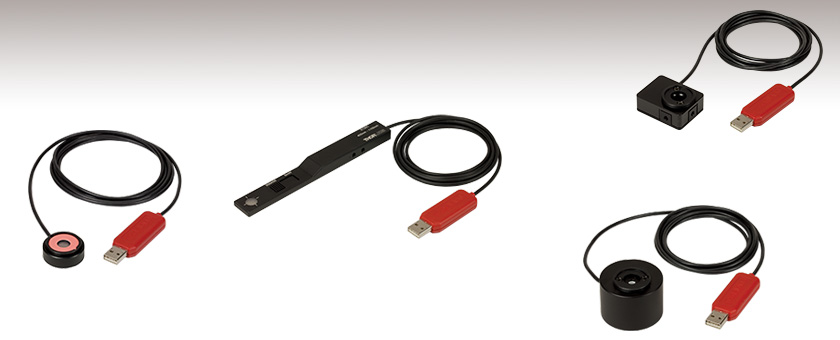
- Power Meters with Sensors and USB 2.0 Connections
- Photodiode Sensors with Wavelength Ranges Between 350 to 1800 nm
- Thermal Sensors for 190 nm to 20 µm
- Power Meter Electronics Contained in Compact USB Housings
PM16-122
Power Meter with Photodiode Sensor, 700 - 1800 nm
PM16-130
Power Meter with Slim Photodiode Sensor, 400 - 1100 nm
PM16-401
Power Meter with Thermal Sensor, 190 nm - 20 µm
PM16-144
Power Meter with Integrating Sphere Sensor, 800 - 1700 nm

Please Wait
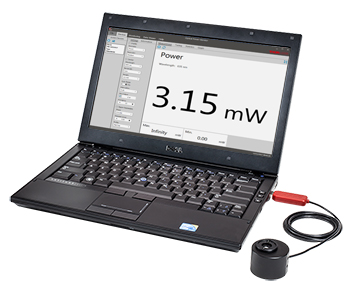
Click to Enlarge
Optical Power Monitorソフトウェアが作動中のノートPCに接続された積分球センサPM16-140C
| Power Meter Selection Guide |
|---|
| Sensors |
| Photodiode Power Sensors |
| Thermal Power Sensors |
| Thermal Position & Power Sensors |
| Pyroelectric Energy Sensors |
| Power Meter Consoles and Interfaces |
| Digital Handheld Console |
| Analog Handheld Console |
| Touchscreen Handheld Console |
| Dual-Channel Benchtop Console |
| USB Interfaces with External Readout |
| Complete Power Meters |
| Power Meter Bundles |
| Wireless Power Meters with Sensors |
| Compact USB Power Meters |
| Field Power Meters for Terminated Fibers |
特長
- パワーメータUSB 2.0インターフェイス
- USBスティック寸法: 65 mm x 20 mm x 10 mm
- 4種類のセンサーヘッドからお選びください
- 標準型フォトダイオードセンサ:400~1800 nm
- 薄型フォトダイオードセンサ:400~1100 nm
- 積分球センサ:350~1700 nm
- サーマルセンサ:190 nm~20 µm
- 適合するファイバーコネクターアダプタについては下記参照
- センサーヘッドはすべてポスト取り付け可能
- 当社のWindows® OS対応Optical Power Monitorソフトウェアパッケージで制御(「ソフトウェア」のタブをご覧ください)
当社製品の中でも最も一般的なセンサーヘッドを、小型のUSBパワーメーターインターフェイスと組み合わせました。操作は当社のOptical Power Monitorソフトウェアパッケージで行います(ダウンロードについては「ソフトウェア」のタブをご覧ください)。センサーヘッドには、当社の標準的なフォトダイオードセンサ、薄型フォトダイオードセンサ、積分球センサならびにサーマルセンサをご用意しております。センサーヘッドにはには1.5 mのケーブル*が付いており、小型USBパッケージ(65 mm x 20 mm x 10 mm)に収められたパワーメータに接続されています。パワーメータはWindows®7 (SP1) ~10に対応する当社のOptical Power Monitorソフトウェアにより制御することができます(ダウンロードについては「ソフトウェア」のタブをご覧ください)。
標準型フォトダイオードセンサ
当社の標準型フォトダイオードセンサを使用したパワーメータとしては3種類あり、400~1100 nm用のシリコン(Si)フォトダイオードと700~1800 nm用のゲルマニウム(Ge)フォトダイオードを用いたものがございます。シリコン(Si)フォトダイオードセンサPM16-120は50 nW~50 mW、PM16-121は500 nW~500 mWの光パワーが検出可能ですが、ゲルマニウム(Ge)フォトダイオードセンサPM16-122は50 nW~40 mWの光パワー測定用に設計されています。フォトダイオードセンサは、速い応答時間と高分解能が必要ですが、平坦なスペクトル特性までは必要としない用途に適しています。
薄型フォトダイオードセンサ
パワーメータPM16-130は当社の薄型フォトダイオードセンサーヘッドを使用しており、スペースやアクセス性が制限された場合に便利です。センサーヘッドには、400~1100 nmの波長に感度のある大面積シリコンフォトダイオードを使用しており、薄さが僅か5 mmの小型の筐体に納められています。スライド式のNDフィルタが組み込まれており、500 pW~5 mW(フィルタ無し)または最大500 mW(フィルタ有り)までの光パワーの測定が可能です。
積分球フォトダイオードセンサ
積分球センサは、不均一あるいは拡散性のあるビームの光パワーを、入射角に依存せず測定することが可能です。350~1100 nm用シリコン(Si)フォトダイオードセンサ(型番PM16-140)ならびに800~1700 nm用ゲルマニウム(Ge)フォトダイオードセンサ(型番PM16-144)をご用意しております。どちらのセンサも1 µW~500 mWの光パワーを検出可能です。
サーマルパワーセンサ
当社の3種類のサーマルパワーセンサーヘッド(S401C、S405C、S425C)を使用したコンパクトなUSBパワーメータをご用意しています。サーマルセンサは幅広い用途にお使いいただけますが、特に平坦なスペクトル特性が必要な用途に適しています。また高いピークパワーによりフォトダイオードセンサの出力が飽和してしまうような超短パルスの測定にも便利です。センサーヘッドS401CおよびS405Cは、低パワー(それぞれ≤1 W、≤5 W)で高分解能な測定(それぞれ1 µW、5 µW)が可能です。また、S401Cはアクティブなバックグラウンド補償による低ドリフトな測定を行うことができます。S425Cの応答速度は0.6秒未満と短く、10 Wまでの連続した光入力に対応します。
USBパワーメーターインターフェイス
この超小型パワーセンサには当社のワイヤレスパワーメータPM160ならびにPM160Tと同様の電子回路が内蔵されており、Optical Power Monitorソフトウェア作動中のPCから制御が可能です(「ソフトウェア」のタブをご覧ください)。
このページに掲載されているパワーメータは、PM16-130以外のすべての入射開口または付属アダプタがSM1外ネジ付きとなっております。PM16-130のみ別途アダプタSM1A29(下記参照)のご購入が必要です。このネジ規格により、センサーヘッドは当社のSM1内ネジ付きファイバーアダプターキャップ(下記参照)が取り付け可能です。
校正
センサーヘッドは全品校正後、NISTおよびPTBトレーサブル校正証明書を付けて出荷されます。校正および識別データはパワーメータのUSBスティックに保存されており、正確な光パワーの測定に適用されます。センサの校正については、当社の「パワーメータ&センサのチュートリアル」のページ内の「校正」タブをご覧ください。
再校正サービス
当社では全てのパワーメータに対して再校正サービスをご提供しております。正確な測定のために、年に1度パワーメータの再校正をお勧めしております。再校正サービスの詳細につきましては、当社までお問い合わせください。
当社のUSBパワーメーターインターフェイスのセンサーヘッド購入をご検討中で、下記にご要望に沿った製品がない場合は、カスタムについて当社までお問い合わせください。
*ケーブルの長さが1.5 m以上ご必要の場合は、 USB延長ケーブルもご用意しています。
USBパワーメータ、標準型フォトダイオードセンサ付き
| Item # | PM16-120 | PM16-121 | PM16-122 |
|---|---|---|---|
| Detector Type | Large Area Silicon Photodiode | Large Area Germanium Photodiode | |
| Wavelength Range | 400 - 1100 nm | 700 - 1800 nm | |
| Optical Power Measurement Range | 50 nW - 50 mW | 500 nW - 500 mW | 50 nW - 40 mW |
| Optical Power Resolution | < 1 nW | < 10 nW | < 2 nW |
| Calibration Uncertaintya,b | ±3% (451 - 1000 nm) ±5% (Over Rest of Range) | ±5% | |
| Linearity | ±0.5% | ||
| Active Area Uniformityb | ±1% | ||
| Max Average Power Densityc | 20 W/cm² | 10 W/cm² | |
| Optical Filter / Diffuser | Reflective ND (OD1) | Reflective ND (OD2) | Absorptive ND (Schott NG9) |
| Response Time | < 1 µs | ||
| Sensor Active Area | 9.7 mm x 9.7 mm | ||
| Sensor Aperture | Ø9.5 mm | ||
| Power Meter Electronics Properties | |||
| Analog Measurement Rangesd | 500 nA, 50 µA, 5 mA | ||
| Measurement Units | W, dBm, A | ||
| AD Converter | 24 Bit | ||
| Analog Amplifier Bandwidth | 10 Hz | ||
| Update Rate | 10 Hz | ||
| Remote Interface | USB 2.0 | ||
| Power Supply | External: 5 V DC via USB | ||
| Dimensions | |||
| Sensor Head Dimensions | Ø30.5 mm x 12.7 mm (1.20" x 0.50") | ||
| USB Housing Dimensions (Including Plug) | 65 mm x 20 mm x 10 mm (2.60" x 0.80" x 0.40") | ||
| Cable Length | 1.5 m | ||
| Weight | 0.07 kg | ||
| Mounting | |||
| Aperture Thread | External SM1 (1.035"-40) | ||
| Post Mounting | 8-32 and M4 Combined Tap | ||
| Compatible Fiber Adapter Item #'s | S120-FC, S120-APC, S120-SMA, S120-ST, S120-SC, S120-LC, S120-25 (Not Included) | ||
USBパワーメータ、薄型フォトダイオードセンサ付き
| Item # | PM16-130 |
|---|---|
| Detector Type | Large Area Silicon Photodiode |
| Wavelength Range | 400 - 1100 nm |
| Optical Power Measurement Range | 500 pW - 5 mW (Up to 500 mW with Filter) |
| Optical Power Resolution | < 100 pW (10 nW with Filter) |
| Calibration Uncertaintya,b | ±3% (451 nm - 1000 nm) ±5% (Over Rest of Range) |
| Linearity | ±0.5% |
| Active Area Uniformityb | ±1% |
| Max Average Power Densityc | 20 W/cm² |
| Max Pulse Energy Density | 0.2 J/cm² (1 µs Pulse), 2 J/cm² (1 ms Pulse) |
| Optical Filter / Diffuser | Reflective ND (OD2) with Diffuser |
| Response Time | < 1 µs |
| Sensor Active Area | 9.7 mm x 9.7 mm |
| Sensor Aperture | Ø9.5 mm |
| Power Meter Electronics Properties | |
| Analog Measurement Rangesd | 500 nA, 50 µA, 5 mA |
| Measurement Units | W, dBm, A |
| AD Converter | 24 Bit |
| Analog Amplifier Bandwidth | 10 Hz |
| Update Rate | 10 Hz |
| Remote Interface | USB 2.0 |
| Power Supply | External: 5 V DC via USB |
| Dimensions | |
| Sensor Head Dimensions | 150.0 mm x 19.0 mm x 10.0 mm (5.91" x 0.75" x 0.39") 5 mm Thickness on Sensor Side |
| USB Housing Dimensions (Including Plug) | 65 mm x 20 mm x 10 mm (2.60" x 0.80" x 0.40") |
| Cable Length | 1.5 m |
| Weight | 0.125 kg |
| Mounting | |
| Aperture Thread | External SM1 (1.035"-40) Threads with Optional Adapter Item #: SM1A29 (Not Included) |
| Post Mounting | 8-32 and M4 Taps |
| Compatible Fiber Adapter Item #'s | S120-FC, S120-APC, S120-SMA, S120-ST, S120-SC, S120-LC, S120-25 (Not Included) When Used with Optional SM1A29 Adapter |
USBパワーメータ、積分球センサ付き
| Item # | PM16-140 | PM16-144 |
|---|---|---|
| Detector Type | Integrating Sphere (Silicon Photodiode) | Integrating Sphere (InGaAs Photodiode) |
| Wavelength Range | 350 - 1100 nm | 800 - 1700 nm |
| Optical Power Measurement Range | 1 µW - 500 mW | |
| Optical Power Resolution | < 1 nW | |
| Calibration Uncertaintya | ±3% (451 nm - 1000 nm) ±5% (Over Rest of Range) | ±5% |
| Linearity | ±0.5% | |
| Max Average Power Densityb | 1 kW/cm² | |
| Integrating Sphere Material / Diameter | Zenith® PTFE Integrating Sphere / Ø1" | |
| Response Time | < 1 µs | |
| Sensor Active Area | 3.6 mm x 3.6 mm | Ø2 mm |
| Sensor Aperture | Ø5 mm | Ø5 mm |
| Power Meter Electronics Properties | ||
| Analog Measurement Rangesc | 500 nA, 50 µA, 5 mA | |
| Measurement Units | W, dBm, A | |
| AD Converter | 24 Bit | |
| Analog Amplifier Bandwidth | 10 Hz | |
| Update Rate | 10 Hz | |
| Remote Interface | USB 2.0 | |
| Power Supply | External: 5 V DC via USB | |
| Dimensions | ||
| Overall Sensor Dimensions | Ø45 mm x 30.5 mm (1.77" x 1.20") | |
| USB Housing Dimensions (Including Plug) | 65 mm x 20 mm x 10 mm (2.60" x 0.80" x 0.40") | |
| Cable Length | 1.5 m | |
| Weight | 0.2 kg | 0.2 kg |
| Mounting | ||
| Aperture Thread | Removable Adapter Plate with External SM1 (1.035"-40) Thread | |
| Post Mounting | 8-32 and M4 Taps | |
| Compatible Fiber Adapter Item #'s | S120-FC (Included) S120-APC, S120-SMA, S120-ST, S120-SC, S120-LC, S120-25 (Not Included) | |
USBパワーメータ、サーマルセンサ付き
| Item # | PM16-401 | PM16-405 | PM16-425 |
|---|---|---|---|
| Detector Type | Thermal Surface Absorber (Thermopile) with Background Compensation | Thermal Surface Absorber (Thermopile) | |
| Wavelength Range | 190 nm - 20 µm | ||
| Optical Power Measurement Range | 10 µW - 1 W | 100 µW - 5 W | 2 mW - 10 W |
| Max Average Optical Power Densitya | 500 W/cm² | 1.5 kW/cm² | |
| Max Pulse Energy Density | 0.2 J/cm² (1 µs Pulse), 2 J/cm² (1 ms Pulse) | 0.3 J/cm² (1 ns Pulse), 5 J/cm² (1 ms Pulse) | 0.3 J/cm² (1 ns Pulse), 5 J/cm² (1 ms Pulse) |
| Max Intermittent Powerb | 3 W | - | 20 W |
| Linearity | ±0.5% | ||
| Optical Power Resolutionc | 1 µW | 5 µW | 100 µW |
| Measurement Uncertaintyd (Calibration Uncertainty) | ±3% @ 1064 nm ±5% @ 190 nm - 10.6 µm | ±3% @ 1064 nm ±5% @ 250 nm - 17 µm | |
| Response Timee | 1.1 s | 1.1 s | 0.6 s |
| Optical Coating | Black Broadband Coating | High Power Broadband Coating | |
| Sensor Aperture | Ø10 mm | Ø10 mm | Ø25.4 mm |
| Sensor Active Area | 10 mm x 10 mm | 10 mm x 10 mm | Ø27 mm |
| Distance to Detectorf | 3 mm | 5 mm | 4.6 mm |
| Active Area Uniformity | ±1% (Beam Diameter >1 mm) | ||
| Cooling | Convection (Passive) | ||
| Temperature Sensor (In Sensor Head) | NTC Thermistor | ||
| Power Meter Electronics Properties | |||
| Analog Measurement Rangesc | 1.6 mV, 25 mV, 400 mV | 1.6 mV, 25 mV, 400 mV | 2.56 mV, 16 mV, 100 mV |
| Measurement Units | W, dBm, V | ||
| AD Converter | 24 Bit | ||
| Analog Amplifier Bandwidth | 10 Hz | ||
| Update Rate | 10 Hz | ||
| Remote Interface | USB 2.0, Type-A Connector | ||
| Power Supply | External: 5 V DC via USB | ||
| Dimensions | |||
| Dimensions of the Sensor Head | 43.0 mm x 33.0 mm x 15 mm (1.69" x 1.30" x 0.59") | 40.6 mm x 40.6 mm x 16.0 mm (1.60" x 1.60" x 0.63") | 50.8 mm x 50.8 mm x 35.0 mm (2.00" x 2.00" x 1.38") |
| USB Housing Dimensions (Including Plug) | 65.0 mm x 20.0 mm x 10.0 mm (2.56" x 0.79" x 0.39") | ||
| Cable Length | 1.5 m | ||
| Weight | 0.07 kg | 0.10 kg | 0.22 kg |
| Mounting | |||
| Aperture Threadg | for Mounting Ø1" Lens Tubes and Fiber Adapters | for Mounting Ø1" Lens Tubes and Fiber Adapters | External SM1-Threaded Adapter for Mounting Ø1" Lens Tubes and Fiber Adapters |
| Post Mounting | Ø1/2" Post via Universal 8-32 & M4 Tap (Post Not Included) | ||
| Cage Compatibility | N/A | 30 mm Cage Systems via Two 4-40 Tapped Holes; Two Ø6 mm Through Holes for ER Series Rods | N/A |
| Compatible Fiber Adapter Item #'s | S120-FC, S120-APC, S120-SMA, S120-ST,S120-SC, S120-LC, S120-25 (Not Included) | ||
対応するパワーメータ
- コンソール
- アナログパワー&エネルギーメーターコンソールPM100A
- デジタルパワー&エネルギーメーターコンソールPM100D
- 静電容量タッチパネル式パワー&エネルギーメーターコンソールPM400
- 2チャンネルベンチトップ型光パワー&エネルギーメーターコンソール(バージョン4.0以降)PM5020
- パワーメータ
- Bluetooth®方式ワイヤレスハンドヘルド型パワーメータPM160、PM160T、PM160T-HP
- 小型USBパワーメータPM16シリーズ
- 光ファイバパワーメータM60およびPM61(バージョン6.0以降)
- インターフェイス
- PM101シリーズパワーメーターインターフェイス、外部読み出しタイプ(バージョン2.0以降)
- PM102シリーズパワーメーターインターフェイス、外部読み出しタイプ(バージョン2.1以降)
- PM103シリーズパワーメーターインターフェイス、外部読み出しタイプ(バージョン3.0以降)
- USB接続デジタルパワー&エネルギーメーターPM100USB
Optical Power Monitor
このGUIソフトウェアOptical Power Monitorには、パワーの測定、最大8台までのパワーメータの読み取り、およびワイヤレスでのリモート操作といった機能があります。
特定のソフトウェア機能の詳細については、こちらこちらからダウンロードいただけるユーザーマニュアルをご覧ください。
旧世代のPower Meter Softwareについてはこちらのソフトウェアページをご覧ください。
PM101シリーズパワーメータはバージョン2.0以降のみに対応します。PM102シリーズパワーメータはバージョン2.1以降のみに対応します。PM103シリーズパワー&エネルギーメータはバージョン3.0以降のみに対応します。コンソールPM5020はバージョン4.0以降にのみ対応します。パワーメータ―シリーズPM60およびPM61はバージョン6.0以降のみに対応します。
タッチパネル型、ハンドヘルド型、およびUSB接続型光パワーメータ用のGUIソフトウェアOptical Power Monitor
特長
- 最大8台までのパワーメータを同時操作
- リアルタイムでの測定値の記録と解析
- 直感的なアナログ表示とグラフモード
- 設定可能な長時間のデータロギング機能
- サーマル位置&パワーセンサによる位置測定もサポート
- USBおよびBluetooth®接続に対応
Optical Power MonitorのGUIを用いると、USB、RS232またはBluetooth®ワイヤレスa接続により最大8台までのパワーメータのシームレスな制御が可能です。パワーメータ用の最新のソフトウェア、ファームウェア、ドライバ、およびユティリティはこちらからダウンロードできます。
このGUIパッケージには、多チャンネルのデータ測定と解析機能が組み込まれています。インターフェイスは使いやすさを考慮した設計になっています。表示色を最小限にし、輝度も低く抑えているため、レーザ用保護メガネを着用しながらの暗い実験室での使用に適しています。測定データはアナログ針、デジタル数値、線グラフ、あるいは棒グラフでリアルタイムに表示できます。連続したログデータや短時間での測定結果は、後でデータの閲覧や解析を行うために記録することできます。組み込まれている統計モードでは測定データの解析を行い、予め設定された測定周期で新しい測定値を反映させ、連続的に更新を行います。当社のサーマル位置&パワーセンサを用いたビーム位置測定にも対応します。
このソフトウェアパッケージOptical Power MonitorでGUIをインストールすると、すぐにタッチパネル型、ハンドヘルド型、またはUSB接続型のパワーメータの制御にご使用いただけます。対応するパワーメータのファームウェアの更新も可能です。当社のパワー&エネルギーメーターコンソールに使用できる、LabVIEW、Visual C++、Visual C#を用いたプログラム例やドライバが、ソフトウェアと一緒にインストールされます。詳細についてはマニュアルをご覧ください。
なお、このOptical Power Monitor Softwareは、Power Meter Utilities Softwareとは異なるドライバを使用しているのでご注意ください。当社では最新のドライバTLPM.dllのご使用をお勧めします。従来のPower Meter Softwareや以前のドライバPM100D.dllを使用したカスタムソフトウェアを使用したい方のために、2つのバージョンのドライバを簡単に切り替えられるプログラムPower Meter Driver Switcherが付属しています。
a. パワーメータPM160、PM160TおよびPM160T-HPにBluetooth®機能が付いています。
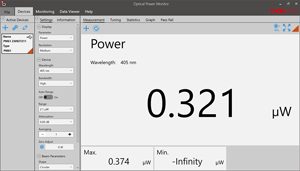
Click to Enlarge
パワー測定モード:最大8台までのパワーメータのセットアップと設定
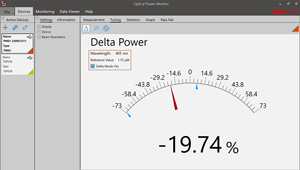
Click to Enlarge
パワーチューニングモード:測定値のアナログ針表示とデジタル数値表示。上図ではデルタモードが有効になっており、測定時間中の変動幅を示しています。

Click to Enlarge
パワー統計モード:予め設定された測定時間における統計量を計算します。上では解析したデータを棒グラフで、計算結果を数値で表示しています。
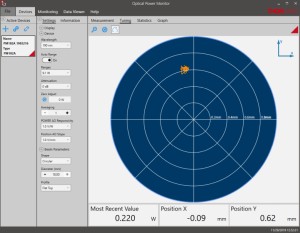
Click to Enlarge
位置チューニングモード:こちらのチューニングモードはサーマル位置&パワーセンサでのビームアライメントにご使用いただけます。
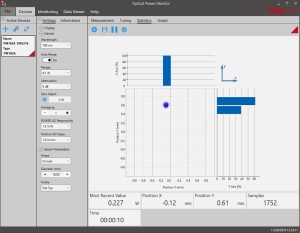
Click to Enlarge
位置統計モード:統計モードではサーマル位置&パワーセンサの統計情報も表示します。
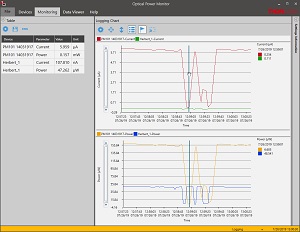
Click to Enlarge
データロギング:長時間測定と最大8台までのパワーメータの同時記録が可能です。データは後処理により.csv形式で保存されますが、測定結果はリアルタイムでグラフ表示されます。
パルスレーザ:パワーとエネルギーの計算
パルスレーザからの放射光が、使用するデバイスや用途に適合するかどうかを判断する上で、レーザの製造元から提供されていないパラメータを参照しなければならない場合があります。このような場合、一般には入手可能な情報から必要なパラメータを算出することが可能です。次のような場合を含めて、必要な結果を得るには、ピークパルスパワー、平均パワー、パルスエネルギ、その他の関連するパラメータを必要とすることがあります。
- 生物試料を損傷させないように保護する
- フォトディテクタなどのセンサにダメージを与えることなくパルスレーザ光を測定する
- 物質内で蛍光や非線形効果を得るために励起を行う
パルスレーザ光のパラメータは下の図1および表に示します。参照用として、計算式の一覧を以下に示します。資料を ダウンロードしていただくと、これらの計算式のほかに、パルスレーザ光の概要、異なるパラメータ間の関係性、および計算式の適用例がご覧いただけます。
計算式 | ||||
 | 、 |  | ||
 | ||||
 | ||||
 | ||||
平均パワーから算出するピークパワー、ピークパワーから算出する平均パワー : | ||||
 | 、 |  | ||
| 平均パワーおよびデューティーサイクルから算出するピークパワー*: | ||||
 | *デューティーサイクル( ) はレーザのパルス光が放射されている時間の割合です。 ) はレーザのパルス光が放射されている時間の割合です。 | |||
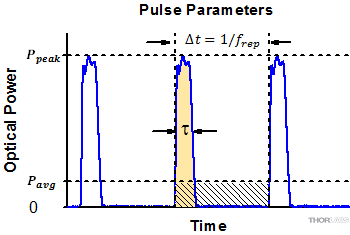
Click to Enlarge
図1: パルスレーザ光の特性を記述するためのパラメータを、上のグラフと下の表に示します。パルスエネルギ (E)は、パルス曲線の下側の黄色の領域の面積に対応します。このパルスエネルギは斜線で表された領域の面積とも一致します。
| パラメータ | シンボル | 単位 | 説明 | ||
|---|---|---|---|---|---|
| パルスエネルギ | E | ジュール[J] | レーザの1周期中に放射される1パルスの全放射エネルギ。 パルスエネルギはグラフの黄色の領域の面積に等しく、 これは斜線部分の面積とも一致します。 | ||
| 周期 | Δt | 秒 [s] | 1つのパルスの開始から次のパルスの開始までの時間 | ||
| 平均パワー | Pavg | ワット[W] | パルスとして放射されたエネルギが、1周期にわたって 均一に広がっていたと仮定したときの、 光パワーの大きさ(光パワー軸上の高さ) | ||
| 瞬時パワー | P | ワット[W] | 特定の時点における光パワー | ||
| ピークパワー | Ppeak | ワット [W] | レーザから出力される最大の瞬時パワー | ||
| パルス幅 |  | 秒 [s] | パルスの開始から終了までの時間。一般的にはパルス形状の 半値全幅(FWHM)を基準にしています。 パルス持続時間とも呼ばれます。 | ||
| 繰り返し周波数 | frep | ヘルツ [Hz] | パルス光が放射される頻度を周波数で表示した量。 周期とは逆数の関係です。 | ||
計算例
下記のパルスレーザ光を測定するのに、最大入力ピークパワーが75 mW
のディテクタを使用するのは安全かどうかを計算してみます。
- 平均パワー: 1 mW
- 繰り返し周波数: 85 MHz
- パルス幅: 10 fs
1パルスあたりのエネルギは、

と低いようですが、ピークパワーは、

となります。このピークパワーはディテクタの
最大入力ピークパワーよりも5桁ほど大きく、
従って、上記のパルスレーザ光を測定するのに
このディテクタを使用するのは安全ではありません。
| Posted Comments: | |
user
(posted 2024-08-23 09:14:14.18) Hi, i am using a PM16-121 and wonder if there is any polarization dependence in the range 400-1100 nm? Is the calibration performed with unpolarized light? Thanks jjadvani
(posted 2024-08-23 09:56:57.0) Dear Felani, Thank you for contacting Thorlabs. For this wavelength range, we employ a non-polarized quartztungsten halogen lamp as the light source. Following that, we employ a triple grating monochromator to select the exact wavelength for calibration, which helps to polarize light slightly but not much. You may learn more about how these sensors are calibrated by clicking on the link below. https://www.thorlabs.com/NewGroupPage9_PF.cfm?ObjectGroup_ID=6188 . I will contact you directly to discuss your issue further. Jie Zhu
(posted 2024-05-06 11:24:15.607) I bought PM16-120 and SM1FCA but seems still missing an adapter ring,please advise which part I should order hchow
(posted 2024-05-06 10:11:13.0) Dear Mr. Zhu, thank you for your valuable feedback. It appears to me that you might have purchased the wrong terminated fiber adapter for your PM16-120. The S120-APC is the correct fiber connector to get. I will personally reach out to you to see how best we can help you. Thank you. Tomas Popelar
(posted 2024-02-14 12:33:34.18) Using the PM16-130 can it be used to detect energy of every laser pulse (repetition rate 500 Hz)?Or is some averaging involved in the measurement? hchow
(posted 2024-02-15 11:30:21.0) Dear Mr. Popelar, thank you for your feedback. The PM16-130's refresh rate is 10 Hz. The average power of 50 or so pulses will be generate the final power measurement reading on your PC. In any case, I will personally reach out to you to provide more information. Patrick Tapping
(posted 2023-06-04 22:00:55.0) Regarding my question below about using these power meters on Linux, they do work fine. I had just forgotten to add the new udev rule to allow read/write access to the device.
After adding the new USB vid=0x1313 and pid=00x807c the PM16-425 works just the same as the PM100 and PM400 using the python pyvisa and ThorlabsPM100 libraries obtained from pypi. GBoedecker
(posted 2023-06-05 07:19:04.0) Dear Patrick, thank you very much for letting us know that it is working now and providing the solution for other users. Patrick Tapping
(posted 2023-06-02 00:44:04.307) Hi,
I have been using both a PM100 and PM400 via USB for remote/headless data logging on a Linux machine using the VISA interface. I just got a PM16-425 as I thought it would be perfect for my application since the display and bulk of the meter body is unnecessary. The "Spec Sheet" on the downloads page (https://www.thorlabs.com/_sd.cfm?fileName=MTN010479-S01.pdf&partNumber=PM16-425) says that it should also use the VISA protocol but on further reading that doesn't appear to be the case?
Is there an older firmware that I can install to get VISA capability or some other way of talking to this device in Linux?
Regards,
Patrick GBoedecker
(posted 2023-06-05 07:25:56.0) Thank you for your feedback. The PM-425 works with the VISA protocol like your other powermeters. See next post. Arun Jana
(posted 2023-01-09 13:16:47.357) for this instrument how we will get the software? and what is the compatibility? hkarpenko
(posted 2023-01-10 07:16:46.0) Dear Arun,
thank you for your feedback.
The software for controlling the power meter via PC can be downloaded directly from our website, a download link can be found in the software tab of this website.
I contact you directly to discuss the compatibility further with you. Ivan Kuyanov
(posted 2022-10-26 10:42:00.837) Hello, Could you send the appropriate drivers and instructions to operate your USB power meters it at linux? We have PM16-130 and we would like to use it under Linux. dpossin
(posted 2022-10-31 05:16:12.0) Dear Ivan,
Thank you for your feedback. I reach out to you in order to provide further information. jason kim
(posted 2022-08-10 10:47:54.03) Thank you for feedback! So, if I enter the beam diameter in the optical powermeter software in mm, the software calculates automatically and know can I think the measured data X "mW" (power) means X "mW/mm^2"(power density) ? jason kim
(posted 2022-08-09 11:44:14.387) Hi, how can I calculate the optical power density from PM16-121 ?
if the data is measured X mW, can I just calculate the density by dividing the data with the area of the aperture(Φ9.5)? dpossin
(posted 2022-08-09 08:32:59.0) Dear Jason,
Thank you for your feedback! The power density is the optical power divided by the beam area which is the beam radius^2 times pi (the circle constant). Either you do the math yourself or you just enter the beam diameter in the optical powermeter software. I reach out to you in order to provide further help. Jacob Thomas
(posted 2022-05-12 08:35:01.923) Hello,
Rather than feedback, a set of questions. I need to measure the power of broadband sources. I normally use your thermal power sensors to do so, but I need faster response time and less interference from relative humidity that I have experienced with the thermal power meters. I was wondering could the PM120 be used with a response flattening filter like your free space biased photodiode detectors? if so would it require a recalibration with this filter attached? Would the software need to recognise this sensor as something else other than a standard pm120 to get the correct readings accounting for the effect of the response flattening filter or would that be dealt with by correcting the the calibration files stored on board the sensor itself?
thanks
jacob soswald
(posted 2022-05-13 10:07:29.0) Dear Jacob,
thank you for your feedback. For measuring broadband light sources with photodiode sensors we would recommend the spectral correction function of the PM400. I have reached out to you directly to discuss this in more detail. lau yan
(posted 2022-04-06 10:46:14.063) the PM16-130 can't connect with the computer Kuang-Po Chang
(posted 2022-02-10 17:32:12.707) Possible to acquire data via Matlab? soswald
(posted 2022-02-11 10:03:26.0) Dear Kuang-Po Chang,
thank you for your feedback. It is possible to integrate our power meters into your Matlab routine, I have reached out to you directly to provide further assistance. James Ludlam
(posted 2022-02-02 09:47:49.33) Is there an API to allow users to integrate taking measurements into their own software? wskopalik
(posted 2022-02-04 05:07:06.0) Thank you very much for your feedback!
Yes, there is an API. The necessary driver files, VIs, etc. are installed with the Optical Power Monitor software package available in the software tab. The folders in which you can find these files are listed in the manual of the Optical Power Monitor software.
I will contact you directly to provide further information. ik Ha
(posted 2021-11-18 03:58:12.537) Hello
I bought the power meter(PM16-425) and PM102 power meter interface(PM102). The power meter is a USB type and the power meter interface is a serial type. Is it possible to use a USB-serial port gender to connect two products?
Reply please. wskopalik
(posted 2021-11-18 11:35:42.0) Thank you very much for your feedback!
The PM16-425 can be directly connected to a computer without the need for an additional interface. It has all the measurement electronics already integrated in the USB stick. The PM102 is not necessary in this case. The two devices cannot be connected in any way either.
I will contact you directly to provide further assistance. John Chiue
(posted 2021-08-24 16:56:42.163) Hi All,
Because the Max Pulse Energy of this power meter is 0.3 J/cm² (1 ns Pulse) on the specifications sheet.
I'd like to confirm if this power meter damaged when my laser is 3-6 ns pulse width, 10 Hz and energy 380 mJ/cm^2 at ~8 mm (1/e² diameter) which is around 1.5 J/cm².
Thanks! soswald
(posted 2021-08-26 08:13:03.0) Dear John,
thank you for your feedback. The 1.5 J/cm² of your laser indeed exceed the damage threshold of 0.3 J/cm² for ns pulses of the PM16-425.
For lasers with high peak powers we recommend sensors like S370C or S470C. Carsten Stock
(posted 2021-07-06 02:26:33.733) Hello, I encouter some issues with the PM16-120 and PM16-121 detectors: for a wider range of use I connect these sensors to a 2m long USB 3.0 extension cable (passive, connected to an active USB hub). Unfortunately this alters the power measurement to higher values (comparing with and without USB extension cable). Is there a possible exlanation for this effect and/or is a workaround available? Does the power measurement depend on the USB voltage?
Many thanks in advance! MKiess
(posted 2021-07-08 05:40:34.0) Dear Carsten, thank you very much for your inquiry. The device is USB powered and if the supply voltage reaches too a low value, the internal voltages would collapse, which could lead to the observed effect. Depending on the cable used, too much supply voltage can drop across the cable over the distance. I have contacted you directly to discuss further details. user
(posted 2021-05-25 16:32:53.323) Can you please specify the reproducibility on the PM16-121? MKiess
(posted 2021-05-31 03:46:35.0) Thank you very much for your inquiry.Here it depends on what kind of reproducibility you are referring to. For the repeatability of the measurement results and thus the precision, the reproducibility is better than 0.1 percent, provided that the incident beam hits the same area on the sensor and at the same angle. I have contacted you directly to discuss further details. Connor Lee
(posted 2021-04-14 13:09:51.587) Hi, how can I know the LIDT of PM16-121 ? soswald
(posted 2021-04-15 09:51:28.0) Dear Connor Lee,
thank you for your feedback. The maximum average power density we recommend for the PM16-121 is 20 W/cm².
For continuous wave (CW) sources, this value is equivalent to the peak power density, while for pulsed laser sources this value is calculated from the time-averaged power and beam profile. Stefano Pirotta
(posted 2021-04-08 09:21:44.923) Dear all, as many other users here we are interested in linux drives for PM16 and PM102. The idea is to use a raspberry (ARM architecture) to control both PMs.
Thanks a lot MKiess
(posted 2021-04-09 07:09:16.0) Dear Stefano, thank you for your inquiry. I have contacted you directly to provide send necessary drivers and provide further assistance. Katharina von Sturm
(posted 2021-04-02 05:04:03.73) Hello, I read in other comments that you can provide drivers for Linux to operate your USB power meters. We just got a PM16-140 and we would like to use it under Linux. Could you send the appropriate drivers and instructions please? MKiess
(posted 2021-04-09 07:05:33.0) Dear Katharina, thank you for your inquiry. I have contacted you directly to provide you with the necessary information and further assistance. Raj Patel
(posted 2021-02-23 17:15:41.2) Can you provide serial commands for PM16-130? We use an old PM100D which we control from Matlab using serial commands and we would like to do the same with PM16-130 but not sure if the same commands are valid. The manual and software installation doesn't provide any information regarding use of serial commands. Is there any file in IVI Foundation that gets installed with the software that can be helpful? wskopalik
(posted 2021-02-26 03:12:50.0) Thank you very much for your inquiry!
You can use the same commands for the PM16-130 as for the PM100D. The manual of the PM100D contains a list of the available commands.
If you use the VISA interface in your MATLAB code, you may need to use the “Power Meter Driver Switcher” software in addition to switch the driver of the PM16-130. The new “Optical Power Monitor” software uses a different driver for the power meters which is not based on the VISA interface. So if you have installed the new software and if you want to use the VISA interface for the communication, you would need to switch to the old driver.
I will also contact you directly to provide further assistance. Bryn Parry
(posted 2020-07-21 16:17:10.763) Hi, do you provide software for your USB power meters which is Linux compatible? Specifically I was hoping to run it on a Raspberry Pi 4. MKiess
(posted 2020-07-22 08:38:24.0) Hello, Thank you very much for your inquiry. We have appropriate drivers for Ubuntu for the optical power monitor software.
I have contacted you directly to discuss further details. Patrick Au
(posted 2020-06-30 14:37:08.677) Would be great if they were also compatible with the Mac OS, or can be interfaced via Python drivers. thanks! wskopalik
(posted 2020-07-02 05:58:37.0) This is a response from Wolfgang at Thorlabs. Thank you very much for your inquiry!
Unfortunately, we don't offer Mac OS support for the PM16 series. We have a wrapper file for the driver and a sample code so the PM16 devices can be used in Python. These are however based on the Windows driver and only work on a Windows system. These files are included in the latest version of the power meter software.
I will contact you directly to provide further assistance. Jing Hou
(posted 2019-12-22 19:00:47.313) I CAN'T download the software via the school net, could you send me an installment package? wskopalik
(posted 2019-12-23 06:53:56.0) This is a response from Wolfgang at Thorlabs. Thank you for your inquiry!
I will contact you directly so we can find a way to send the software to you. sri g
(posted 2019-12-16 09:31:49.203) Hi for PM16-425 - USB Power Meter, I cannot measure any power from the device even by just using a white light source. Though when I tried an UV source and fixed the wavelength around 420, it shows some power output.
Can you tell me, what could be possible issue with the device. nreusch
(posted 2019-12-18 04:36:51.0) This is a response from Nicola at Thorlabs. Thank you for reporting this issue. As long as you use a light source in between 2 mW and 10 W in e.g. the visible wavelength range, you should be able to detect the optical power. Are you able to perform the zeroing properly? I will contact you directly to resolve the issue. Jeff Chen
(posted 2019-07-18 09:17:32.387) Hi,
I'd like to ask if the PM16-121 can be calibrated NIST traceable power versus wavelength? wskopalik
(posted 2019-07-22 10:56:00.0) This is a response from Wolfgang at Thorlabs. Thank you for your inquiry!
Each sensor head is individually calibrated and is shipped with a NIST- and PTB-traceable calibration certificate. For the calibration, the responsivity of the sensor head is measured over the whole wavelength range. The responsivity is the ratio of the current generated by the photodiode and the incident power in this case.
I will contact you directly to provide further information. Daniel Gagnon
(posted 2019-05-24 19:27:35.55) Hi this is for PM16-121. I'd like to know if it's possible for me to gain access to the calibration data for my specific unit? MKiess
(posted 2019-05-31 06:22:47.0) This is a response from Michael at Thorlabs. Thank you very much for your inquiry. Yes, it is possible to get the calibration data for your specific sensor. I will contact you directly and be happy to send you the data. Patrick_Lee
(posted 2019-02-13 17:58:48.567) Hi for PM16-121 - USB Power Meter, possible to set integration time for calculating average power of pulse laser ? wskopalik
(posted 2019-02-21 05:27:14.0) This is a response from Wolfgang at Thorlabs. Thank you very much for your inquiry!
The internal integration time is unfortunately determined by the AD converter used in these sensors. It cannot be changed. So it depends mainly on the parameters of your laser (e.g. repetition rate, pulse duration) if the PM16-121 is suitable or not. In general, thermal power sensors are better suited for pulsed lasers due to their measurement principle.
I will contact you directly so we can look for a good solution for your application. itswonie
(posted 2018-11-07 09:04:40.21) There are some questions about "PM16-130"
I already have a fluorescense light source which is connected to a microscope for optogenetic experiments and I would like to measure the light power.
- Is it ok that I use the PM16-130 for this measurement?
- Is software free for use?
Please let me know.
Thank you. nreusch
(posted 2018-11-15 07:10:26.0) This is a response from Nicola at Thorlabs. Thank you for your inquiry! The PM16-130 is designed to be used to measure light in a wavelength range of 400-1100 nm and an optical power range between 500 pW up to 5 mW (without filter) or 500 mW (with filter). Do these features match to your light source? The software is available free of charge at https://www.thorlabs.com/software_pages/ViewSoftwarePage.cfm?Code=OPM. I will contact you directly to check whether you need any further assistance. massimo
(posted 2017-09-21 09:25:02.703) As specified in the spec-sheet, the viewing target is removable. I've noticed that on the other side it is white. Can I assume it is reflective and for which wavelength?
I'm asking this because I'm using the power meter in an integrating sphere with a non-monochromatic light and I was wondering if mounting the target the other way around would offer a reflectance similar to the one of the surface of the integrating sphere.
Thanks swick
(posted 2017-10-05 03:41:20.0) This is a response from Sebastian at Thorlabs. Thank you for the inquiry.
The substrate material used for the viewing target is not precisely defined.
It is some sort of hard plastic.
Basically the reflectivity is not specified but should be better than for the fluorescing side.
I will contact you directly for further discussion. xiang.zhan
(posted 2017-09-05 18:47:00.38) Hi! I'm now selecting a suitable equipment to measure the intensity of my light source. The light source is a Xenon type, and I would use filters to generate 370-750nm wavelength range, which is a broadband.We have a uncalibrated spectrometer which can measure the relative light intensity with the wavelength (like a spectrum). I have three questions:1)if I would like to measure the absolute intensity, which equipment would you recommend? 2)Supposing that I have a PM16-401, as I understand,I have to enter a specific wavelength then get a intensity result in the software. Does the result represent the intensity at the wavelength I entered? Or it measures the total power? 3) For me it's also enough to get the overall intensity/power of the brandband, do you have a suitable equipment? Thanks! wskopalik
(posted 2017-09-07 10:01:24.0) This is a response from Wolfgang at Thorlabs. Thank you for the inquiry.
For a broadband light source thermal sensors such as the PM16-401 are a good choice. The PM16-401 has a flat absorption curve in your spectral range so the wavelength dependence is very low. You can see a diagram of this curve on the website.
The wavelength you enter will determine the calibration factor which is used for the conversion of the sensor signal to a power value. Due to the flat absorption in this range you can simply enter a value in the middle of your range e.g. 560nm.
Powermeter sensors cannot separate the light of different wavelengths, they can only measure the total power. So the power value will represents the total power of the incoming beam.
I have also contacted you directly to provide further assistance. bjorn.agnarsson
(posted 2017-08-28 10:20:39.153) I was trying to use the PM16-140 to evaluate my microscope Mercury lightsource spectrum and noticed that as I measure light power as a function of wavelength, the response is very linear, dropping from high power to low with increasing wavelength.
This is not normal, as peaks should appear in accordance with the emission spectra of the lightsource.
Am I missing something here? Can the power meter maybe not be used to measure absolute power, only relative power changes.
I am very confused...
All help, would be much appreciated.
Best regards,
Björn swick
(posted 2017-08-29 04:56:41.0) This is a response from Sebastian at Thorlabs. Thank you for the inquiry.
The PM16-140 is based on an Integrating Sphere equipped with a Photodiode. It can be used to measure the absolute optical power traceable to a National Standard.
The responsivity vs wavelength is not constant for this sensor. When measuring broadband sources the results have to be corrected in view of the light sources' spectrum. In our Power Meter Consoles PM400 and PM200 the spectral correction can be applied directly in the console. In case the spectrum is known it can be loaded into the console and the displayed values will be automatically corrected. Unfortunately, in our PM16-Series this feature is not implemented. I will contact you directly for assistance. stijn.moonen
(posted 2017-05-03 08:33:48.717) Hi, currently I am using a PM16-140 power meter. So far I am very happy about its performance. Now I wat to extend my measurement and perform the measurement at a higher temperature. Thus I am curious about the operating temperature of this specific power meter. Can you help me with this?
Best regards,
Stijn Moonen swick
(posted 2017-05-05 03:26:18.0) This is a response from Sebastian at Thorlabs. Thank you very much for the feedback. The operating temperature of the power meter consoles and sensors is 0-40°C, while calibration of the sensors is valid for 23-25°C. Outside of 23-25°C additional uncertainty will occur. You can expect the uncertainty to be 0.1%/°C at most wavelengths. At the sides of the wavelength ranges (especially above 1600nm) the uncertainty could raise to 1%/°C.
The power meter consoles and sensors could be damaged above 70°C. Ville.kontturi
(posted 2017-04-24 10:33:01.24) Dear Mr/Mrs,
How many measurements PM16-120 can perform in one second?
Best regards,
Ville Kontturi swick
(posted 2017-04-26 03:12:29.0) This is a response from Sebastian at Thorlabs. Thank you for the inquiry.
The number of measurements in one second depends on the quality of the USB connection and the operating system of the PC. In our Optical Power Meter Utility the min. interval time PM16-Series is 0.1s. ngaber
(posted 2016-01-22 18:05:24.087) Dear Sir,
We purchased the sensor PM16-401 and found in the datasheet the warning that it is sensitive to electrostatic discharges. Isn't it shielded? what are the precautions during handling?
Thanks in advance shallwig
(posted 2016-01-26 02:05:17.0) This is a response from Stefan at Thorlabs. Thank you very much for your inquiry, the precautions and warnings mentioned in the spec sheet were accidently copied from data sheets for photodiode sensors. The units are shielded and there is no special precaution necessary during handling. I am sorry for the confusion, I will contact you directly to check if you have any further questions. loic.morvan
(posted 2015-12-07 10:56:19.357) Hello,
will the software be compatible with a eWindows 10 Home 64" environment ?
Many thanks by advance,
best regards,
Loïc shallwig
(posted 2015-12-07 08:42:37.0) This is a response from Stefan at Thorlabs. Thank you very much for your inquiry. The software for our power meter units is compatible up to Windows 10 and down compatible to Windows XP.
I will contact you directly to check any further questions. user
(posted 2015-06-05 17:16:10.307) If the new sensors are wireless, we are more happy. shallwig
(posted 2015-06-05 07:21:04.0) This is a response from Stefan at Thorlabs. Thank you very much for your feedback. At the moment the only wireless power meter we offer can be found here: http://www.thorlabs.com/newgrouppage9.cfm?objectgroup_ID=7233&pn=PM160
There are two different sensors available so far, one thermal and one photodiode sensor. If you have any questions about these power meters or any other please feel free also to contact us directly at europe@thorlabs.com |

| Item #a | PM16-120 | PM16-121 | PM16-122 |
|---|---|---|---|
| Detector Type | Silicon Photodiode | Germanium Photodiode | |
| Wavelength Range | 400 - 1100 nm | 700 - 1800 nm | |
| Optical Power Range | 50 nW - 50 mW | 500 nW - 500 mW | 50 nW - 40 mW |
| Aperture Size | Ø9.5 mm | ||
| Resolution | < 1 nW | < 10 nW | < 2 nW |
| ND Filter | Reflective ND (OD1) | Reflective ND (OD2) | Absorptive ND (Schott NG9) |
| Sensor Housing Dimensions | Ø30.5 mm x 12.7 mm (1.2" x 0.50") | ||
| Post Mounting | 8-32 and M4 Combined Tap | ||
- 一般的な光パワー測定用
- シリコン(Si):400~1100 nm
- ゲルマニウム(Ge):700~1800 nm
- センサのアライメントを容易にするビュワーターゲット付き
- センサ開口部:Ø9.5 mm
- 保護キャップが付属
こちらの標準型フォトダイオードセンサ付きUSBパワーメータは、400~1100 nm(シリコンフォトダイオード)または700~1800 nm(ゲルマニウムフォトダイオード)の比較的低パワーのコヒーレント光ならびにインコヒーレント光の測定に適しています。NISTトレーサブルな校正済みセンサで、検出部はØ9.5 mmと大きく、入射開口の周りには400~640 nmならびに800~1700 nmの波長を吸収する環状のビュワーターゲットが付いています。
筐体の前面はSM1外ネジ付きで、当社のØ25 mm~Ø25.4 mm(Ø1インチ)のレンズチューブや他のアクセサリに対応しており、ファイバーアダプタ(下記参照)、フィルタ、開口などの他の外付け光学素子を取り付ける際に便利です。筐体側面の#8-32とM4タップ穴により、ミリ規格、インチ規格両方のポストに対応します。
当社ではこちらの製品の再校正サービスをご提供しています。詳細につきましては、当社までお問い合わせください。

| Item #a | PM16-130 |
|---|---|
| Detector Type | Silicon Photodiode |
| Wavelength Range | 400 - 1100 nm |
| Optical Power Range (with Filter) | 500 pW - 5 mW (Up to 500 mW) |
| Aperture Size | Ø9.5 mm |
| Resolution | < 100 pW (10 nW with Filter) |
| ND Filter | Reflective ND (OD2) |
| Housing Dimensions | 150.0 mm x 19.0 mm x 10.0 mm (5.91" x 0.75" x 0.39") 5 mm Thickness on Sensor Side |
| Post Mounting | 8-32 and M4 Taps |
- 限られたスペースでの光パワー測定用
- 波長範囲:400~1100 nm
- 光パワー測定範囲:500 pW~5 mW(NDフィルタを用いて最大500 mWまで)
- 付属のスライド式NDフィルタの位置を自動的に検出し、確度の高い光パワー測定を実現
- 薄型設計:センサの厚さ5 mm
- センサ開口部:Ø9.5 mm
- 別途VIS/IRターゲットとSM1外ネジ付きアダプタSM1A29をご用意(詳細はこちら)
- 別途FiberBenchシステム向けVIS/IRターゲット付きマウントFBSMをご用意(詳細はこちら)
薄型シリコン(Si)フォトダイオードセンサ付き小型USBパワーメータPM16-130は、スペースやアクセス性が制限された場所での光パワーの測定用として設計されています。センサの厚さが僅か5 mmなので近接配置した光学素子の間やケージシステムの中など、標準のパワーメータを設置することのできない場所でもご使用になれます。NISTトレーサブルな校正済みセンサで、Ø9.5 mmの大きな開口も特長です。またスライド式のNDフィルタが付いているため、コンパクトなデバイス1つで2つのパワーレンジでの測定が可能です。
別売りのアダプタSM1A29はSM1外ネジ付きで、2つの止めネジ(セットスクリュ)でセンサーヘッドに取り付けます。これにより、ファイバーアダプタ(下記参照)、遮光体、フィルタなどのほか、様々なSM1シリーズのネジ付き部品や光学素子を取り付けることが出来ます。フォトダイオードマウントFBSMをお使いいただくとS130シリーズの薄型フォトダイオードセンサをFiberBench システムに垂直に取り付けることができます。これにより、小さな設置面積で安定した取付けが可能になります。
当社ではこちらの製品の再校正サービスをご提供しています。詳細につきましては、当社までお問い合わせください。

| Item #a | PM16-140 | PM16-144 |
|---|---|---|
| Detector Type | Integrating Sphere (Silicon Photodiode) | Integrating Sphere (InGaAs Photodiode) |
| Wavelength Range | 350 - 1100 nm | 800 - 1700 nm |
| Optical Power Range | 1 µW - 500 mW | |
| Aperture Size | Ø5 mm | |
| Resolution | < 1 nW | |
| Integrating Sphere Material / Diameter | Zenith® PTFE Integrating Sphere / Ø1" | |
| Sensor Housing Dimensions | Ø45 mm x 30.5 mm (1.77" x 1.20") | |
| Post Mounting | 8-32 and M4 Taps | |
| Included Fiber Adapter | S120-FC for FC/PC and FC/APC Connectors | |
- ビーム形状や入射角に依存しない光パワー測定用
- 積分球が光パワー損失を最小限にする拡散器として機能
- 入射開口部:Ø5 mm
- 取り外し可能なファイバーアダプタS120-FC(FC/PCならびにFC/APC)が付属
こちらの積分球フォトダイオードセンサ付き小型USBパワーメータは、不均一性や拡散性のあるビームのパワーを入射角に依存せず測定するのに適しています。積分球センサは、ファイバ光源のパワー測定にも、光軸から外れた空間伝搬する光源のパワー測定にも適しています。
積分球センサの入射開口部はØ5 mm、入射ポートはSM1外ネジ付きになっております。センサの検出部が大きいため、付属のファイバーアダプタS120-FCにはFC/PCまたはFC/APCコネクタ付きファイバを接続することができます。その他のコネクタ用のファイバーアダプタについては下記をご参照ください。NISTトレーサブルな校正データがパワーメータ内に保存されており、正確な光パワーの測定が可能になっています。
当社ではこちらの製品の再校正サービスをご提供しています。詳細につきましては、当社までお問い合わせください。


Click to Enlarge
付属の遮光体を取り付けたサーマルセンサPM16-401
- 10 µW~20 Wの光パワーを広帯域で測定可能
- PM16-401: 低ドリフトで高分解能
- アクティブなバックグラウンド補償機能
- 長さ29.4 mmの取り外し可能な遮光体が付属
- PM16-405: 分解能は5 µW、パワー密度は1.5 kW/cm²
- PM16-425: 入射開口はØ25.4 mm、最大光パワーは10 W
これらのセンサはサーモパイル型で、自然放射増幅光(ASE)、発光ダイオード(LED)、白熱電球、波長掃引レーザなどの広帯域スペクトル光源の測定にお使いいただけます。また、サーマルパワーセンサは飽和しないので、高いピークパワーや長いパルス幅を有するパルス光源の測定にも適しています。サーマルパワーセンサは入射光の角度や位置に対する依存性も大きくありません。これは、フォトダイオードセンサの顕著な波長依存性や飽和閾値を許容できない用途には望ましい特性ですが、一般にサーマルパワーセンサのパワー分解能はフォトダイオードよりも低く、応答時間は長くなります。
全ての製品には入射開口部と同心のSM1外ネジ付きアダプタが付属します。このアダプタはØ25 mm~Ø25.4 mm(Ø1インチ)レンズチューブやファイバーアダプタ(下記掲載)を取り付ける際に便利です。PM16-405の開口部にはSM05内ネジが付いており、SM05レンズチューブに直接取り付けることができます。また、#4-40タップ穴とØ6 mmの貫通穴もあり、当社の30 mmケージシステムに直接取り付けられるようになっています。 PM16-425の開口部にはSM1内ネジが付いており、SM1レンズチューブに直接取り付けられます。
PM16-401およびPM16-405は、高分解能で高感度な測定を必要とする低パワー光源の測定に適しています。センサーヘッドPM16-401はアクティブなバックグラウンド補償が可能で、1 µWの分解能で低ドリフトな測定を行うことができます。中赤外域(MIR)量子カスケードレーザ(QCL)のアライメントや測定に適しています。センサーヘッドPM16-405は、5 µWという高い分解能を有しながら、大きな光パワー密度の測定にも対応できます。PM16-425の応答時間は0.6秒未満と速く、取り外しが容易なヒートシンクはアップグレードしやすく、またカスタムセットアップ内でのセンサの構築も容易に行えます。 ヒートシンクを交換する場合には、交換後のヒートシンクが用途に適した放熱を行えるようにしてください。
当社ではこちらの製品の再校正サービスをご提供しています。詳細につきましては、当社までお問い合わせください。

こちらのSM1内ネジ付きアダプタはフォトダイオードパワーセンサ、サーマルパワーセンサ、そしてフォトディテクタをはじめとする当社の全てのSM1外ネジ付き部品とコネクタ付きファイバを接続させることができます。
ナローキーとワイドキーの詳細については、光ファイバとはのページをご覧ください。アダプタが取り付け可能かどうかが不確かな場合には当社までご連絡くさい。
APCアダプタには 2つの窪みがあるので、どちらの面からもスパナレンチSPW909またはSPW801を用いて締め付け可能です。このアダプタをSM1レンズチューブと遮光用途でお使いいただけるように、窪みはディスクを貫通していません。
フェルール用アダプタS120-25は、ロッキングコネクタ機構無しの設計になっています。Ø2.5 mmフェルール付きのファイバーパッチケーブルに対応し、フォトディテクタやパワーセンサを用いた測定を迅速に行うことができます。

※パワーセンサ校正について - 当社のパワーセンサ校正は自動で行われており、測定と同時にセンサ内のメモリにある補正データを書き換えます(出力されるデータは校正前の感度と校正後の感度になります)。また、センサ面(NDフィルタ)が汚れ等で正常に感度測定ができないと判断された場合には、フィルタ交換(無償)してから校正される場合がございますので、ご了承ください。この場合は校正前の感度は測定できません。
To ensure accurate measurements, we recommend recalibrating the power meters above annually.
Requesting a Calibration
Thorlabs provides two options for requesting a calibration:
- Complete the Returns Material Authorization (RMA) form. When completing the RMA form, please enter your name, contact information, the Part #, and the Serial # of the item being returned for calibration; in the Reason for Return field, select "I would like an item to be calibrated." All other fields are optional. Once the form has been submitted, a member of our RMA team will reach out to provide an RMA Number, return instructions, and to verify billing and payment information.
- Enter the Part # and Serial # of the item that requires recalbration below and then Add to Cart. A member of our RMA team will reach out to coordinate return of the item for calibration. Should you have other items in your cart, note that the calibration request will be split off from your order for RMA processing. Refer to the table below for the appropriate recalibration service Item # that corresponds to your power meter.
| USB Power Meter Item # | Sensor Type | Recalibration Service Item # |
|---|---|---|
| PM16-120 | Standard Photodiode with Si Sensor | CAL-PD |
| PM16-121 | ||
| PM16-122 | Standard Photodiode with Ge Sensor | CAL-IRPD |
| PM16-130 | Slim Photodiode with Si Sensor | CAL-PD2 |
| PM16-140 | Integrating Sphere with Si Sensor | CAL-PD |
| PM16-144 | Integrating Sphere with InGaAs Sensor | CAL-IRPD |
| PM16-401 | Thermal Sensor | CAL-THPY |
| PM16-405 | ||
| PM16-425 |
Please Note: To ensure your item being returned for calibration is routed appropriately once it arrives at our facility, please do not ship it prior to being provided an RMA Number and return instructions by a member of our team.
 Products Home
Products Home

















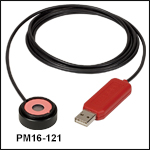
 ズーム
ズーム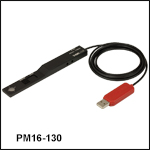
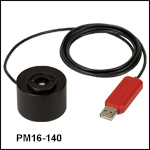
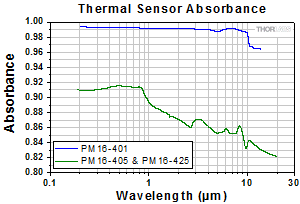
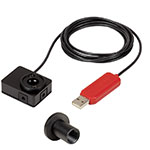
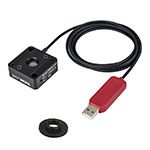
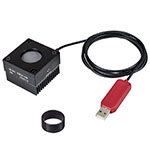









 小型USBパワーメータ
小型USBパワーメータ